Report on Gen Y Retention and Coworker Traits in the Workplace
VerifiedAdded on 2022/11/18
|14
|3640
|360
Report
AI Summary
This report examines the factors influencing Generation Y (Millennial) employee retention in the workplace. It analyzes the problem of employee attrition, particularly focusing on the shift from Baby Boomers to Gen Y, and how technological advancements and changing workplace expectations impact retention rates. The research design involves a literature review and a quantitative primary survey using a close-ended questionnaire distributed to 300 employees from six companies. The study employs positivism philosophy and a deductive approach to analyze the data, utilizing an explanatory research design to establish cause-effect relationships between workplace culture, Gen Y expectations, and retention. The key variables include workplace culture and employee expectations as independent variables and Gen Y retention as the dependent variable. Simple random sampling is used for data collection. The report aims to identify the mental setup of Millennials and the types of working environments that facilitate retention, along with evaluating how workplace culture can be remodeled to reduce attrition. The findings are presented with recommended activities to modify workplaces for Gen Y employees.
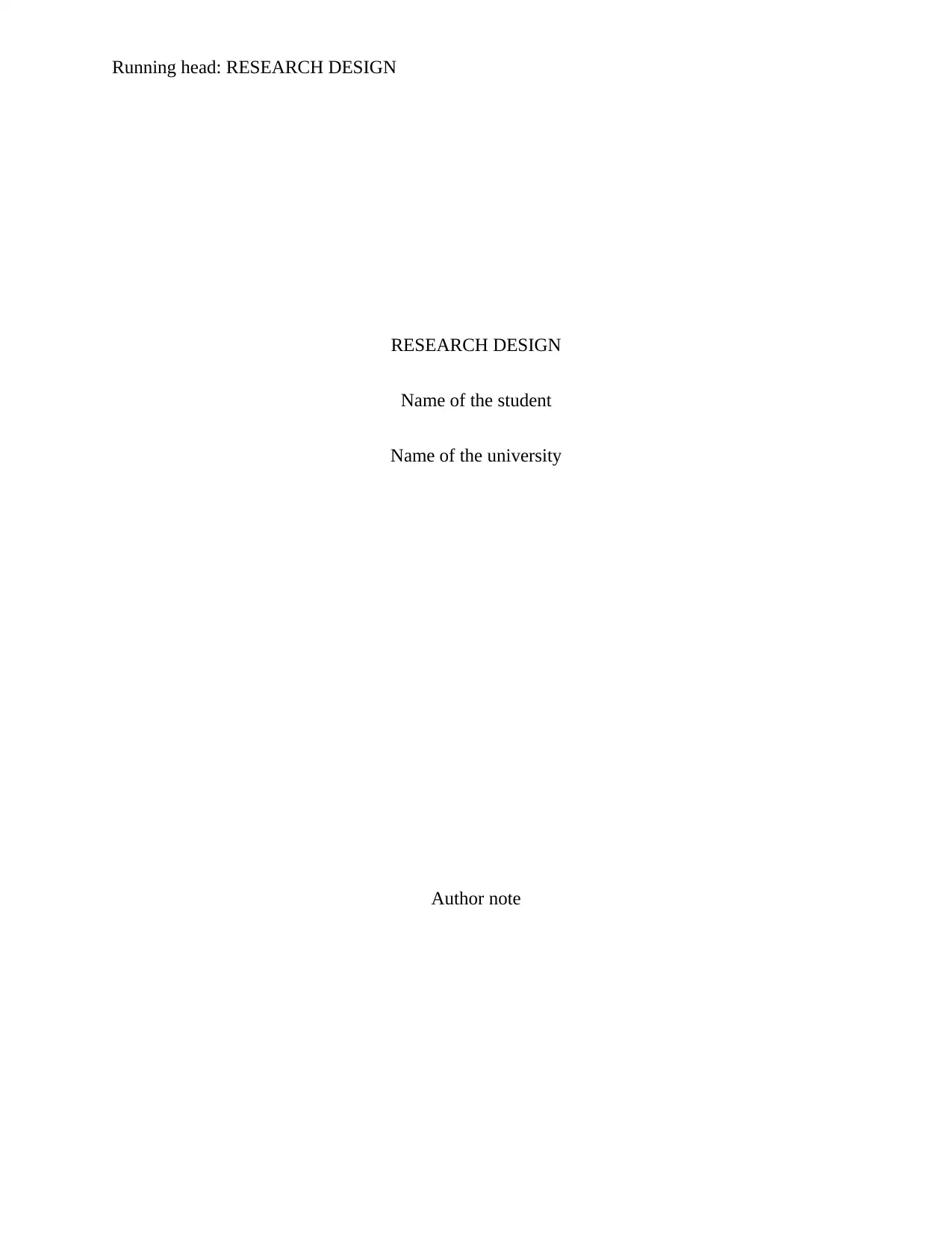
Running head: RESEARCH DESIGN
RESEARCH DESIGN
Name of the student
Name of the university
Author note
RESEARCH DESIGN
Name of the student
Name of the university
Author note
Paraphrase This Document
Need a fresh take? Get an instant paraphrase of this document with our AI Paraphraser
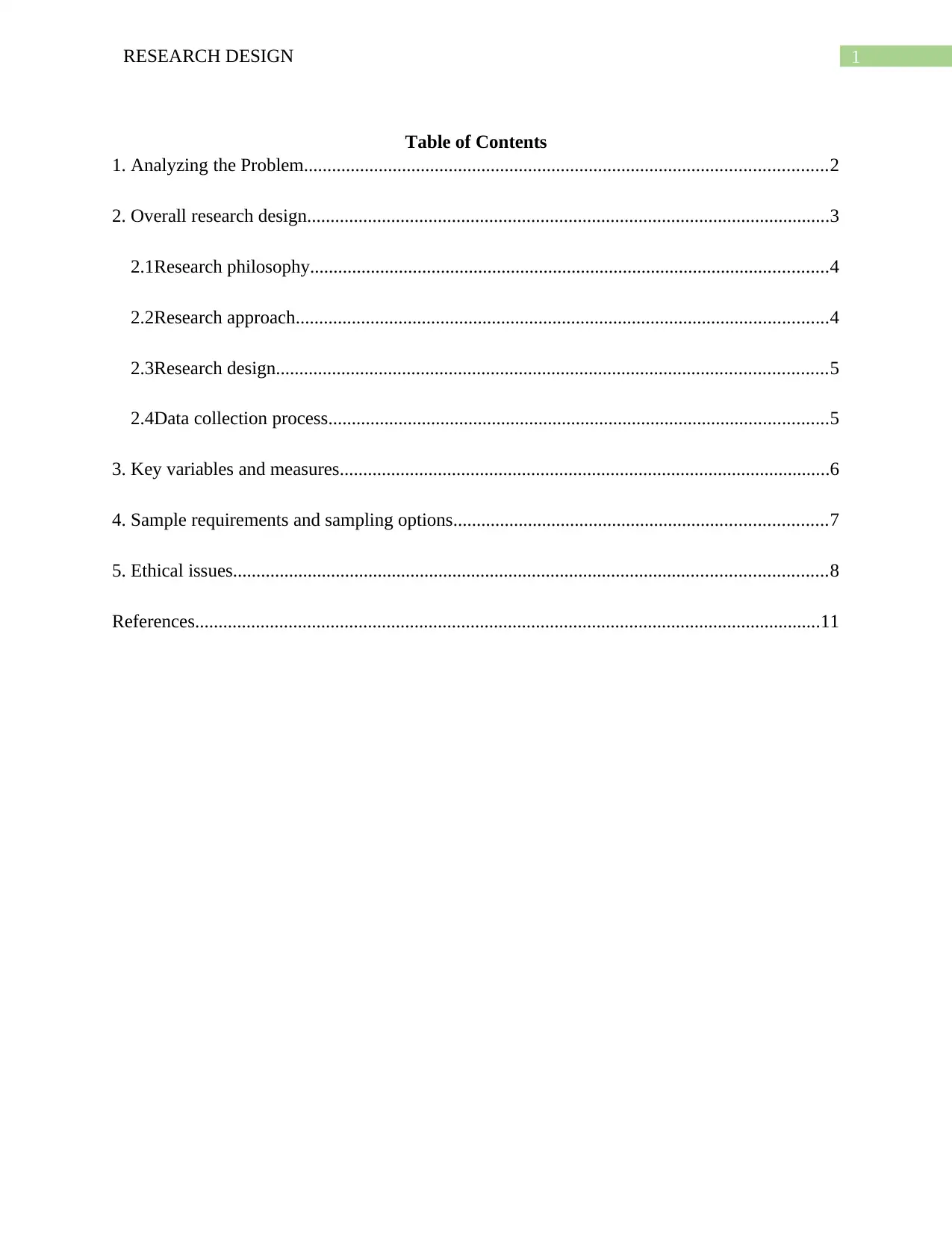
1RESEARCH DESIGN
Table of Contents
1. Analyzing the Problem................................................................................................................2
2. Overall research design................................................................................................................3
2.1Research philosophy...............................................................................................................4
2.2Research approach..................................................................................................................4
2.3Research design......................................................................................................................5
2.4Data collection process...........................................................................................................5
3. Key variables and measures.........................................................................................................6
4. Sample requirements and sampling options................................................................................7
5. Ethical issues...............................................................................................................................8
References......................................................................................................................................11
Table of Contents
1. Analyzing the Problem................................................................................................................2
2. Overall research design................................................................................................................3
2.1Research philosophy...............................................................................................................4
2.2Research approach..................................................................................................................4
2.3Research design......................................................................................................................5
2.4Data collection process...........................................................................................................5
3. Key variables and measures.........................................................................................................6
4. Sample requirements and sampling options................................................................................7
5. Ethical issues...............................................................................................................................8
References......................................................................................................................................11
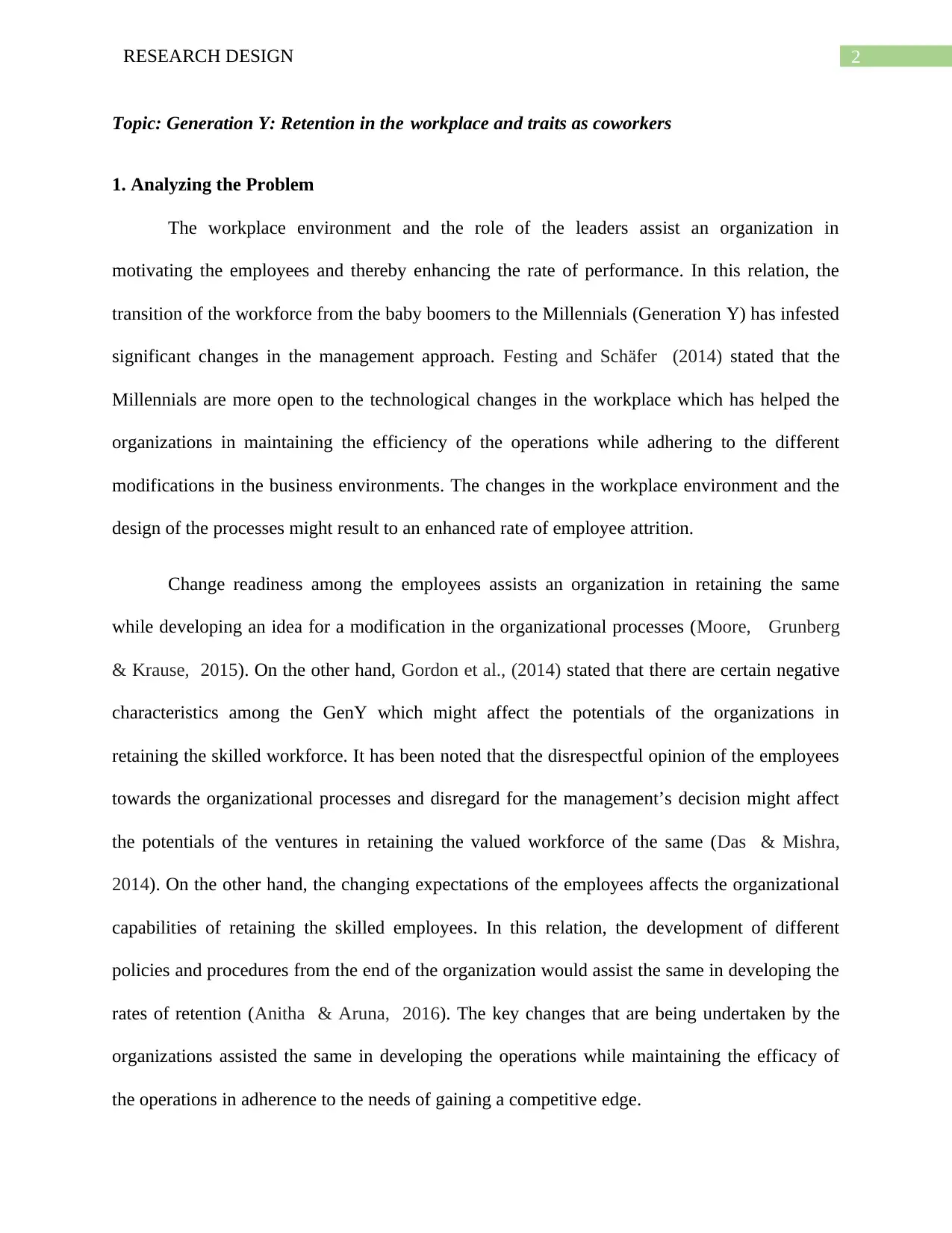
2RESEARCH DESIGN
Topic: Generation Y: Retention in the workplace and traits as coworkers
1. Analyzing the Problem
The workplace environment and the role of the leaders assist an organization in
motivating the employees and thereby enhancing the rate of performance. In this relation, the
transition of the workforce from the baby boomers to the Millennials (Generation Y) has infested
significant changes in the management approach. Festing and Schäfer (2014) stated that the
Millennials are more open to the technological changes in the workplace which has helped the
organizations in maintaining the efficiency of the operations while adhering to the different
modifications in the business environments. The changes in the workplace environment and the
design of the processes might result to an enhanced rate of employee attrition.
Change readiness among the employees assists an organization in retaining the same
while developing an idea for a modification in the organizational processes (Moore, Grunberg
& Krause, 2015). On the other hand, Gordon et al., (2014) stated that there are certain negative
characteristics among the GenY which might affect the potentials of the organizations in
retaining the skilled workforce. It has been noted that the disrespectful opinion of the employees
towards the organizational processes and disregard for the management’s decision might affect
the potentials of the ventures in retaining the valued workforce of the same (Das & Mishra,
2014). On the other hand, the changing expectations of the employees affects the organizational
capabilities of retaining the skilled employees. In this relation, the development of different
policies and procedures from the end of the organization would assist the same in developing the
rates of retention (Anitha & Aruna, 2016). The key changes that are being undertaken by the
organizations assisted the same in developing the operations while maintaining the efficacy of
the operations in adherence to the needs of gaining a competitive edge.
Topic: Generation Y: Retention in the workplace and traits as coworkers
1. Analyzing the Problem
The workplace environment and the role of the leaders assist an organization in
motivating the employees and thereby enhancing the rate of performance. In this relation, the
transition of the workforce from the baby boomers to the Millennials (Generation Y) has infested
significant changes in the management approach. Festing and Schäfer (2014) stated that the
Millennials are more open to the technological changes in the workplace which has helped the
organizations in maintaining the efficiency of the operations while adhering to the different
modifications in the business environments. The changes in the workplace environment and the
design of the processes might result to an enhanced rate of employee attrition.
Change readiness among the employees assists an organization in retaining the same
while developing an idea for a modification in the organizational processes (Moore, Grunberg
& Krause, 2015). On the other hand, Gordon et al., (2014) stated that there are certain negative
characteristics among the GenY which might affect the potentials of the organizations in
retaining the skilled workforce. It has been noted that the disrespectful opinion of the employees
towards the organizational processes and disregard for the management’s decision might affect
the potentials of the ventures in retaining the valued workforce of the same (Das & Mishra,
2014). On the other hand, the changing expectations of the employees affects the organizational
capabilities of retaining the skilled employees. In this relation, the development of different
policies and procedures from the end of the organization would assist the same in developing the
rates of retention (Anitha & Aruna, 2016). The key changes that are being undertaken by the
organizations assisted the same in developing the operations while maintaining the efficacy of
the operations in adherence to the needs of gaining a competitive edge.
⊘ This is a preview!⊘
Do you want full access?
Subscribe today to unlock all pages.

Trusted by 1+ million students worldwide
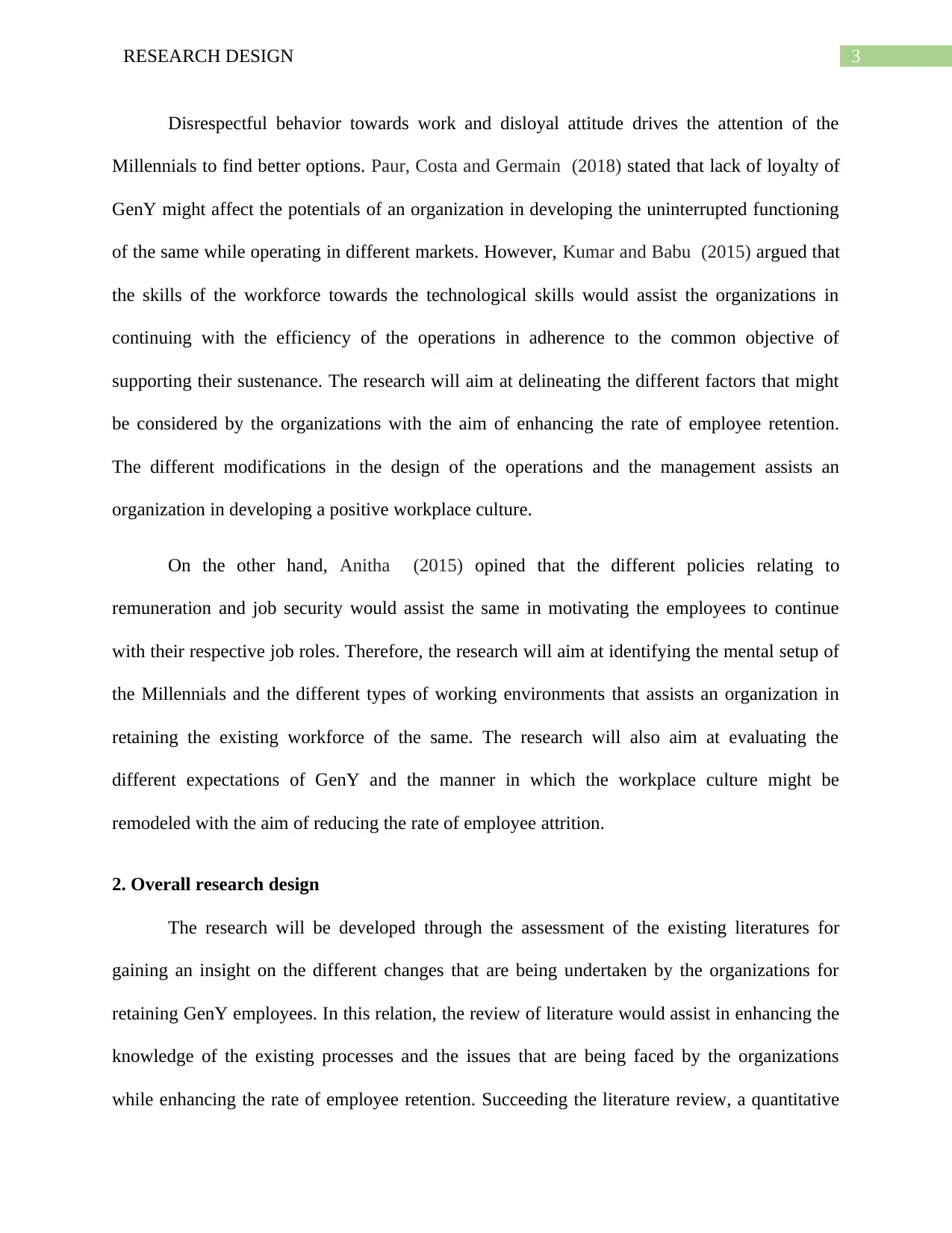
3RESEARCH DESIGN
Disrespectful behavior towards work and disloyal attitude drives the attention of the
Millennials to find better options. Paur, Costa and Germain (2018) stated that lack of loyalty of
GenY might affect the potentials of an organization in developing the uninterrupted functioning
of the same while operating in different markets. However, Kumar and Babu (2015) argued that
the skills of the workforce towards the technological skills would assist the organizations in
continuing with the efficiency of the operations in adherence to the common objective of
supporting their sustenance. The research will aim at delineating the different factors that might
be considered by the organizations with the aim of enhancing the rate of employee retention.
The different modifications in the design of the operations and the management assists an
organization in developing a positive workplace culture.
On the other hand, Anitha (2015) opined that the different policies relating to
remuneration and job security would assist the same in motivating the employees to continue
with their respective job roles. Therefore, the research will aim at identifying the mental setup of
the Millennials and the different types of working environments that assists an organization in
retaining the existing workforce of the same. The research will also aim at evaluating the
different expectations of GenY and the manner in which the workplace culture might be
remodeled with the aim of reducing the rate of employee attrition.
2. Overall research design
The research will be developed through the assessment of the existing literatures for
gaining an insight on the different changes that are being undertaken by the organizations for
retaining GenY employees. In this relation, the review of literature would assist in enhancing the
knowledge of the existing processes and the issues that are being faced by the organizations
while enhancing the rate of employee retention. Succeeding the literature review, a quantitative
Disrespectful behavior towards work and disloyal attitude drives the attention of the
Millennials to find better options. Paur, Costa and Germain (2018) stated that lack of loyalty of
GenY might affect the potentials of an organization in developing the uninterrupted functioning
of the same while operating in different markets. However, Kumar and Babu (2015) argued that
the skills of the workforce towards the technological skills would assist the organizations in
continuing with the efficiency of the operations in adherence to the common objective of
supporting their sustenance. The research will aim at delineating the different factors that might
be considered by the organizations with the aim of enhancing the rate of employee retention.
The different modifications in the design of the operations and the management assists an
organization in developing a positive workplace culture.
On the other hand, Anitha (2015) opined that the different policies relating to
remuneration and job security would assist the same in motivating the employees to continue
with their respective job roles. Therefore, the research will aim at identifying the mental setup of
the Millennials and the different types of working environments that assists an organization in
retaining the existing workforce of the same. The research will also aim at evaluating the
different expectations of GenY and the manner in which the workplace culture might be
remodeled with the aim of reducing the rate of employee attrition.
2. Overall research design
The research will be developed through the assessment of the existing literatures for
gaining an insight on the different changes that are being undertaken by the organizations for
retaining GenY employees. In this relation, the review of literature would assist in enhancing the
knowledge of the existing processes and the issues that are being faced by the organizations
while enhancing the rate of employee retention. Succeeding the literature review, a quantitative
Paraphrase This Document
Need a fresh take? Get an instant paraphrase of this document with our AI Paraphraser
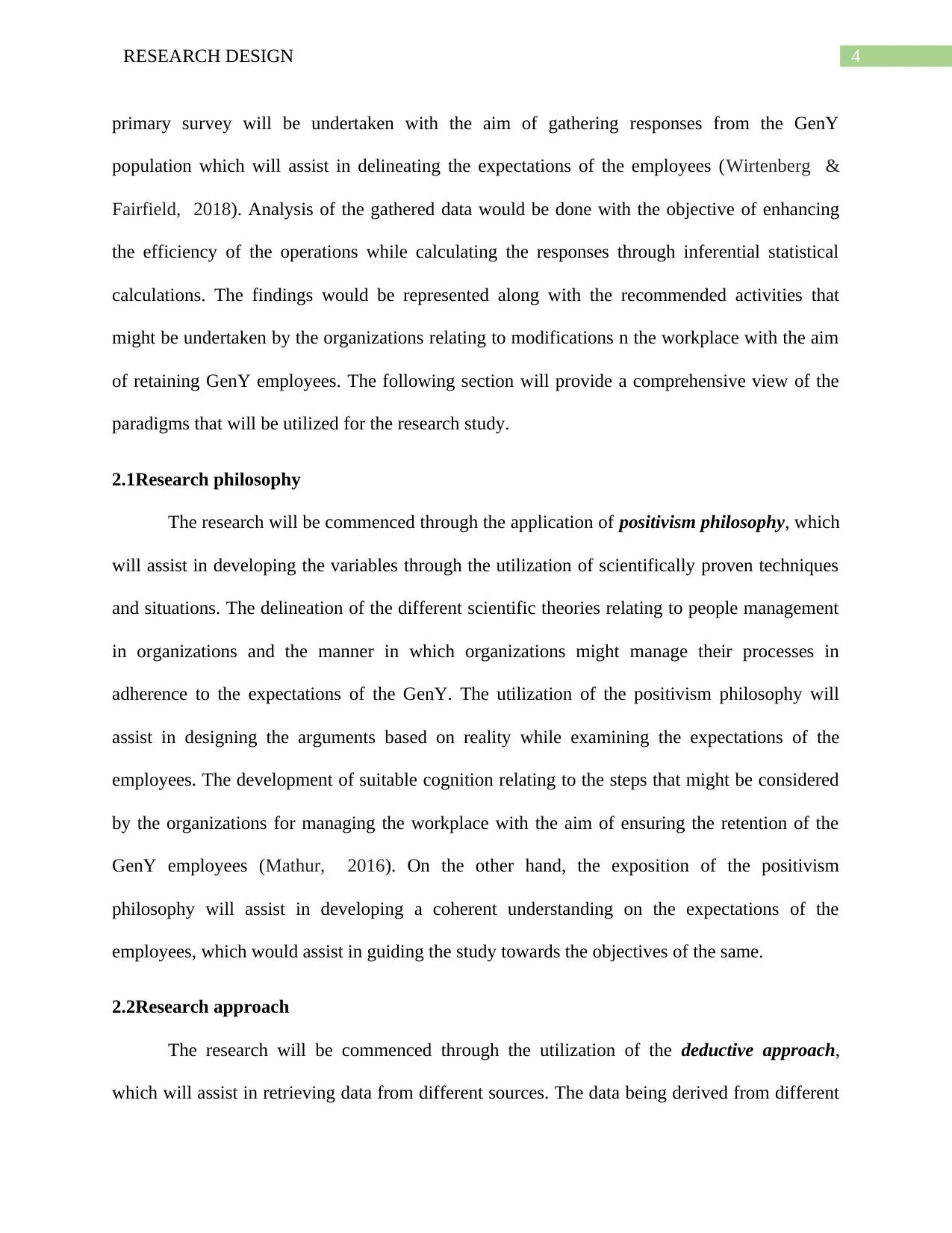
4RESEARCH DESIGN
primary survey will be undertaken with the aim of gathering responses from the GenY
population which will assist in delineating the expectations of the employees (Wirtenberg &
Fairfield, 2018). Analysis of the gathered data would be done with the objective of enhancing
the efficiency of the operations while calculating the responses through inferential statistical
calculations. The findings would be represented along with the recommended activities that
might be undertaken by the organizations relating to modifications n the workplace with the aim
of retaining GenY employees. The following section will provide a comprehensive view of the
paradigms that will be utilized for the research study.
2.1Research philosophy
The research will be commenced through the application of positivism philosophy, which
will assist in developing the variables through the utilization of scientifically proven techniques
and situations. The delineation of the different scientific theories relating to people management
in organizations and the manner in which organizations might manage their processes in
adherence to the expectations of the GenY. The utilization of the positivism philosophy will
assist in designing the arguments based on reality while examining the expectations of the
employees. The development of suitable cognition relating to the steps that might be considered
by the organizations for managing the workplace with the aim of ensuring the retention of the
GenY employees (Mathur, 2016). On the other hand, the exposition of the positivism
philosophy will assist in developing a coherent understanding on the expectations of the
employees, which would assist in guiding the study towards the objectives of the same.
2.2Research approach
The research will be commenced through the utilization of the deductive approach,
which will assist in retrieving data from different sources. The data being derived from different
primary survey will be undertaken with the aim of gathering responses from the GenY
population which will assist in delineating the expectations of the employees (Wirtenberg &
Fairfield, 2018). Analysis of the gathered data would be done with the objective of enhancing
the efficiency of the operations while calculating the responses through inferential statistical
calculations. The findings would be represented along with the recommended activities that
might be undertaken by the organizations relating to modifications n the workplace with the aim
of retaining GenY employees. The following section will provide a comprehensive view of the
paradigms that will be utilized for the research study.
2.1Research philosophy
The research will be commenced through the application of positivism philosophy, which
will assist in developing the variables through the utilization of scientifically proven techniques
and situations. The delineation of the different scientific theories relating to people management
in organizations and the manner in which organizations might manage their processes in
adherence to the expectations of the GenY. The utilization of the positivism philosophy will
assist in designing the arguments based on reality while examining the expectations of the
employees. The development of suitable cognition relating to the steps that might be considered
by the organizations for managing the workplace with the aim of ensuring the retention of the
GenY employees (Mathur, 2016). On the other hand, the exposition of the positivism
philosophy will assist in developing a coherent understanding on the expectations of the
employees, which would assist in guiding the study towards the objectives of the same.
2.2Research approach
The research will be commenced through the utilization of the deductive approach,
which will assist in retrieving data from different sources. The data being derived from different
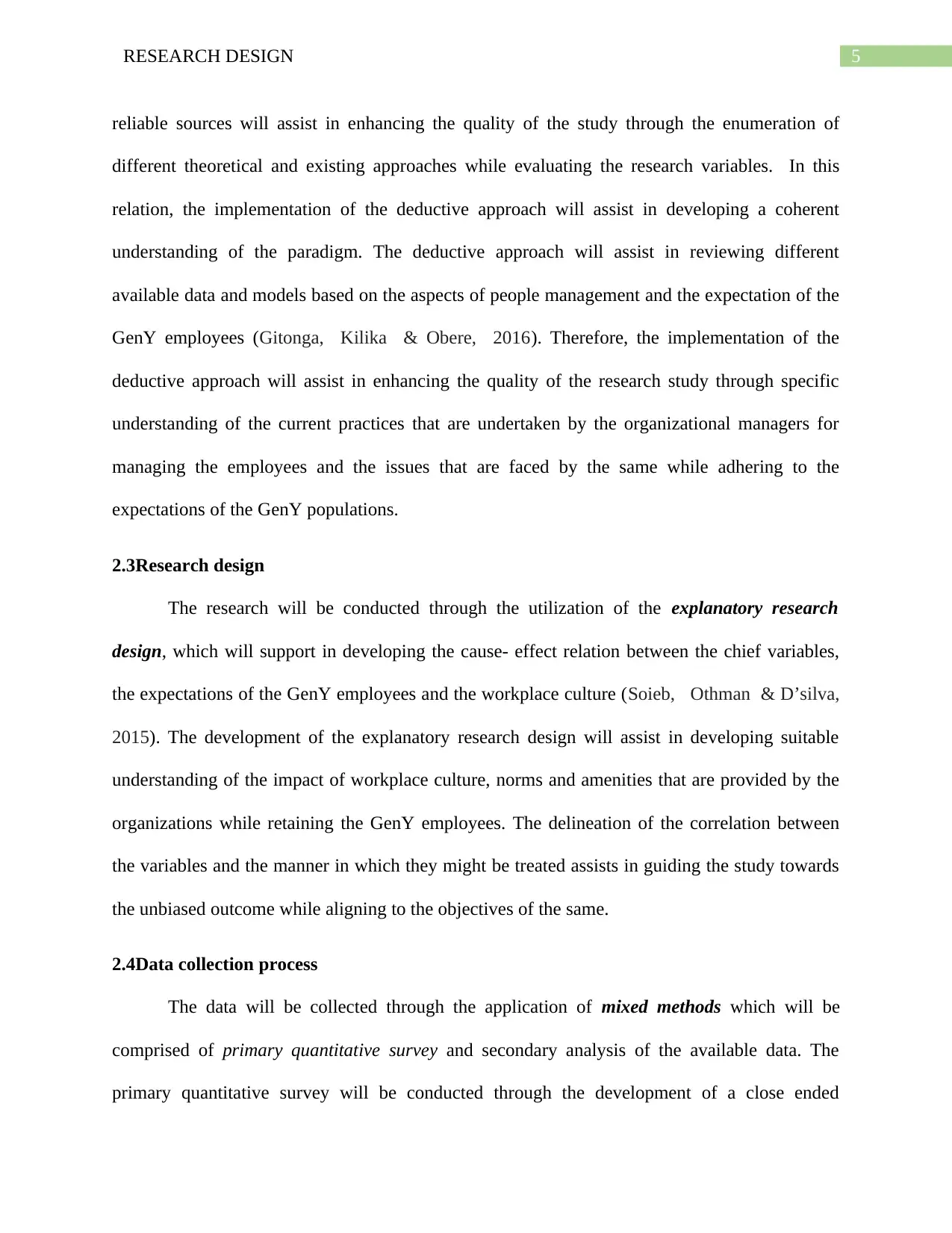
5RESEARCH DESIGN
reliable sources will assist in enhancing the quality of the study through the enumeration of
different theoretical and existing approaches while evaluating the research variables. In this
relation, the implementation of the deductive approach will assist in developing a coherent
understanding of the paradigm. The deductive approach will assist in reviewing different
available data and models based on the aspects of people management and the expectation of the
GenY employees (Gitonga, Kilika & Obere, 2016). Therefore, the implementation of the
deductive approach will assist in enhancing the quality of the research study through specific
understanding of the current practices that are undertaken by the organizational managers for
managing the employees and the issues that are faced by the same while adhering to the
expectations of the GenY populations.
2.3Research design
The research will be conducted through the utilization of the explanatory research
design, which will support in developing the cause- effect relation between the chief variables,
the expectations of the GenY employees and the workplace culture (Soieb, Othman & D’silva,
2015). The development of the explanatory research design will assist in developing suitable
understanding of the impact of workplace culture, norms and amenities that are provided by the
organizations while retaining the GenY employees. The delineation of the correlation between
the variables and the manner in which they might be treated assists in guiding the study towards
the unbiased outcome while aligning to the objectives of the same.
2.4Data collection process
The data will be collected through the application of mixed methods which will be
comprised of primary quantitative survey and secondary analysis of the available data. The
primary quantitative survey will be conducted through the development of a close ended
reliable sources will assist in enhancing the quality of the study through the enumeration of
different theoretical and existing approaches while evaluating the research variables. In this
relation, the implementation of the deductive approach will assist in developing a coherent
understanding of the paradigm. The deductive approach will assist in reviewing different
available data and models based on the aspects of people management and the expectation of the
GenY employees (Gitonga, Kilika & Obere, 2016). Therefore, the implementation of the
deductive approach will assist in enhancing the quality of the research study through specific
understanding of the current practices that are undertaken by the organizational managers for
managing the employees and the issues that are faced by the same while adhering to the
expectations of the GenY populations.
2.3Research design
The research will be conducted through the utilization of the explanatory research
design, which will support in developing the cause- effect relation between the chief variables,
the expectations of the GenY employees and the workplace culture (Soieb, Othman & D’silva,
2015). The development of the explanatory research design will assist in developing suitable
understanding of the impact of workplace culture, norms and amenities that are provided by the
organizations while retaining the GenY employees. The delineation of the correlation between
the variables and the manner in which they might be treated assists in guiding the study towards
the unbiased outcome while aligning to the objectives of the same.
2.4Data collection process
The data will be collected through the application of mixed methods which will be
comprised of primary quantitative survey and secondary analysis of the available data. The
primary quantitative survey will be conducted through the development of a close ended
⊘ This is a preview!⊘
Do you want full access?
Subscribe today to unlock all pages.

Trusted by 1+ million students worldwide
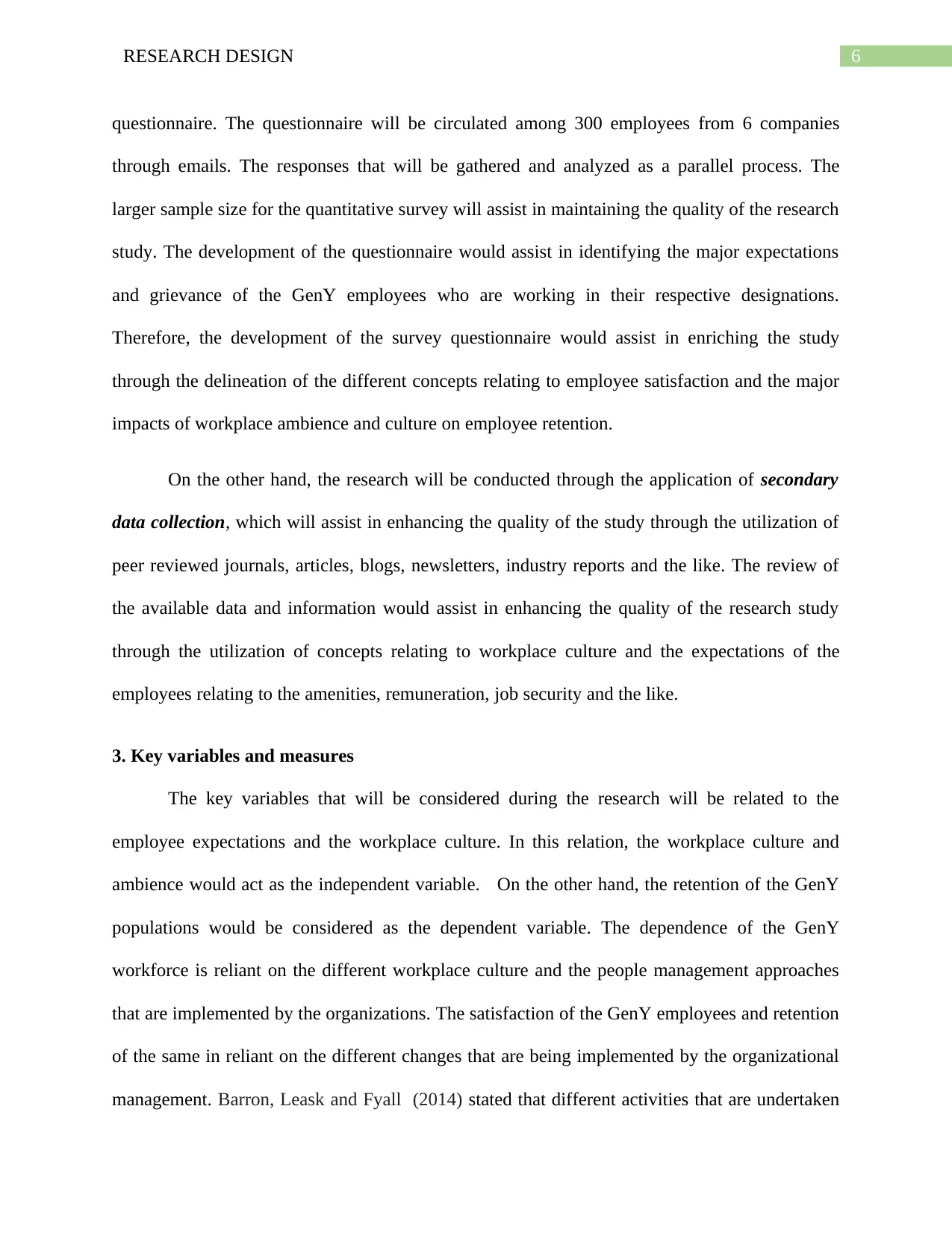
6RESEARCH DESIGN
questionnaire. The questionnaire will be circulated among 300 employees from 6 companies
through emails. The responses that will be gathered and analyzed as a parallel process. The
larger sample size for the quantitative survey will assist in maintaining the quality of the research
study. The development of the questionnaire would assist in identifying the major expectations
and grievance of the GenY employees who are working in their respective designations.
Therefore, the development of the survey questionnaire would assist in enriching the study
through the delineation of the different concepts relating to employee satisfaction and the major
impacts of workplace ambience and culture on employee retention.
On the other hand, the research will be conducted through the application of secondary
data collection, which will assist in enhancing the quality of the study through the utilization of
peer reviewed journals, articles, blogs, newsletters, industry reports and the like. The review of
the available data and information would assist in enhancing the quality of the research study
through the utilization of concepts relating to workplace culture and the expectations of the
employees relating to the amenities, remuneration, job security and the like.
3. Key variables and measures
The key variables that will be considered during the research will be related to the
employee expectations and the workplace culture. In this relation, the workplace culture and
ambience would act as the independent variable. On the other hand, the retention of the GenY
populations would be considered as the dependent variable. The dependence of the GenY
workforce is reliant on the different workplace culture and the people management approaches
that are implemented by the organizations. The satisfaction of the GenY employees and retention
of the same in reliant on the different changes that are being implemented by the organizational
management. Barron, Leask and Fyall (2014) stated that different activities that are undertaken
questionnaire. The questionnaire will be circulated among 300 employees from 6 companies
through emails. The responses that will be gathered and analyzed as a parallel process. The
larger sample size for the quantitative survey will assist in maintaining the quality of the research
study. The development of the questionnaire would assist in identifying the major expectations
and grievance of the GenY employees who are working in their respective designations.
Therefore, the development of the survey questionnaire would assist in enriching the study
through the delineation of the different concepts relating to employee satisfaction and the major
impacts of workplace ambience and culture on employee retention.
On the other hand, the research will be conducted through the application of secondary
data collection, which will assist in enhancing the quality of the study through the utilization of
peer reviewed journals, articles, blogs, newsletters, industry reports and the like. The review of
the available data and information would assist in enhancing the quality of the research study
through the utilization of concepts relating to workplace culture and the expectations of the
employees relating to the amenities, remuneration, job security and the like.
3. Key variables and measures
The key variables that will be considered during the research will be related to the
employee expectations and the workplace culture. In this relation, the workplace culture and
ambience would act as the independent variable. On the other hand, the retention of the GenY
populations would be considered as the dependent variable. The dependence of the GenY
workforce is reliant on the different workplace culture and the people management approaches
that are implemented by the organizations. The satisfaction of the GenY employees and retention
of the same in reliant on the different changes that are being implemented by the organizational
management. Barron, Leask and Fyall (2014) stated that different activities that are undertaken
Paraphrase This Document
Need a fresh take? Get an instant paraphrase of this document with our AI Paraphraser
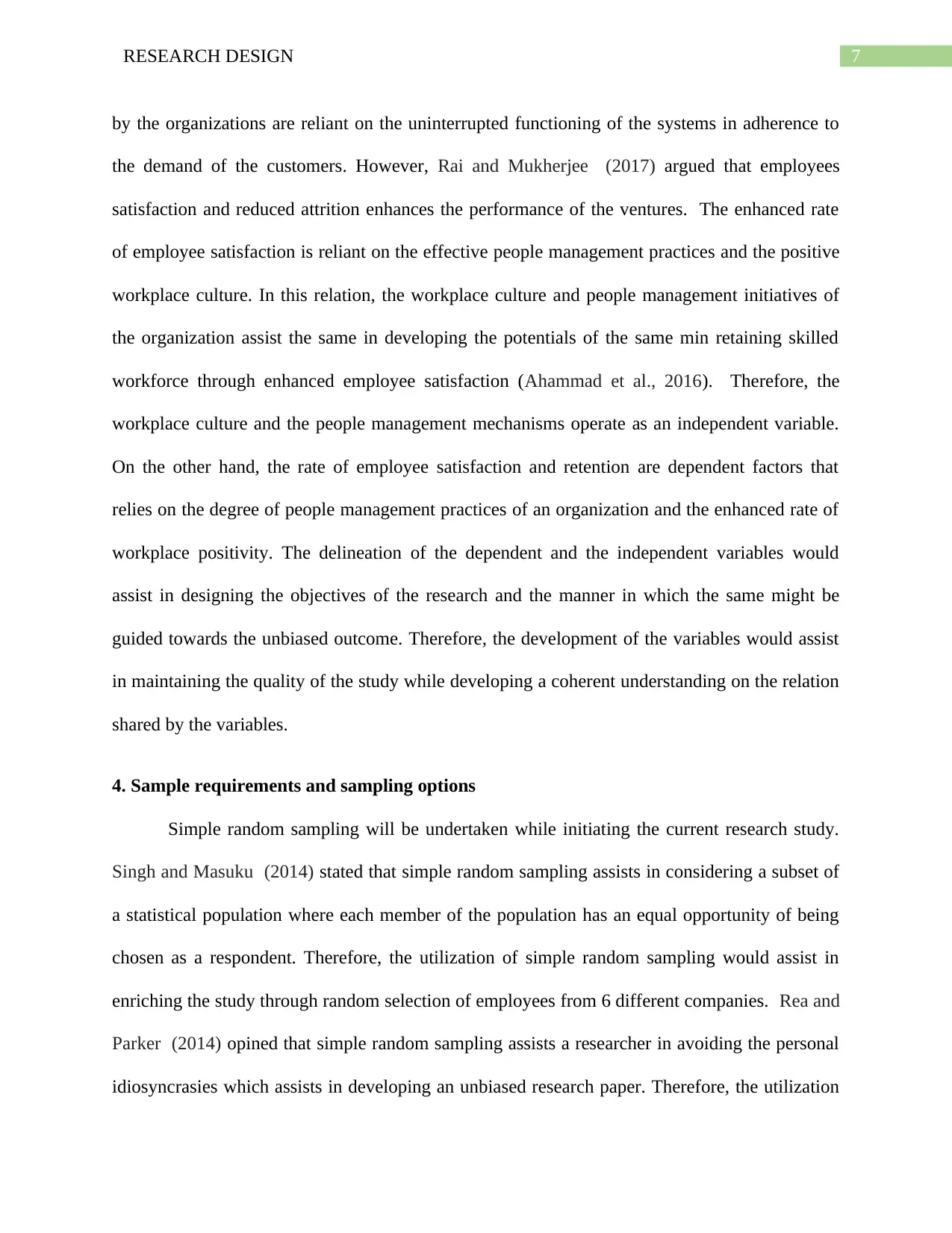
7RESEARCH DESIGN
by the organizations are reliant on the uninterrupted functioning of the systems in adherence to
the demand of the customers. However, Rai and Mukherjee (2017) argued that employees
satisfaction and reduced attrition enhances the performance of the ventures. The enhanced rate
of employee satisfaction is reliant on the effective people management practices and the positive
workplace culture. In this relation, the workplace culture and people management initiatives of
the organization assist the same in developing the potentials of the same min retaining skilled
workforce through enhanced employee satisfaction (Ahammad et al., 2016). Therefore, the
workplace culture and the people management mechanisms operate as an independent variable.
On the other hand, the rate of employee satisfaction and retention are dependent factors that
relies on the degree of people management practices of an organization and the enhanced rate of
workplace positivity. The delineation of the dependent and the independent variables would
assist in designing the objectives of the research and the manner in which the same might be
guided towards the unbiased outcome. Therefore, the development of the variables would assist
in maintaining the quality of the study while developing a coherent understanding on the relation
shared by the variables.
4. Sample requirements and sampling options
Simple random sampling will be undertaken while initiating the current research study.
Singh and Masuku (2014) stated that simple random sampling assists in considering a subset of
a statistical population where each member of the population has an equal opportunity of being
chosen as a respondent. Therefore, the utilization of simple random sampling would assist in
enriching the study through random selection of employees from 6 different companies. Rea and
Parker (2014) opined that simple random sampling assists a researcher in avoiding the personal
idiosyncrasies which assists in developing an unbiased research paper. Therefore, the utilization
by the organizations are reliant on the uninterrupted functioning of the systems in adherence to
the demand of the customers. However, Rai and Mukherjee (2017) argued that employees
satisfaction and reduced attrition enhances the performance of the ventures. The enhanced rate
of employee satisfaction is reliant on the effective people management practices and the positive
workplace culture. In this relation, the workplace culture and people management initiatives of
the organization assist the same in developing the potentials of the same min retaining skilled
workforce through enhanced employee satisfaction (Ahammad et al., 2016). Therefore, the
workplace culture and the people management mechanisms operate as an independent variable.
On the other hand, the rate of employee satisfaction and retention are dependent factors that
relies on the degree of people management practices of an organization and the enhanced rate of
workplace positivity. The delineation of the dependent and the independent variables would
assist in designing the objectives of the research and the manner in which the same might be
guided towards the unbiased outcome. Therefore, the development of the variables would assist
in maintaining the quality of the study while developing a coherent understanding on the relation
shared by the variables.
4. Sample requirements and sampling options
Simple random sampling will be undertaken while initiating the current research study.
Singh and Masuku (2014) stated that simple random sampling assists in considering a subset of
a statistical population where each member of the population has an equal opportunity of being
chosen as a respondent. Therefore, the utilization of simple random sampling would assist in
enriching the study through random selection of employees from 6 different companies. Rea and
Parker (2014) opined that simple random sampling assists a researcher in avoiding the personal
idiosyncrasies which assists in developing an unbiased research paper. Therefore, the utilization
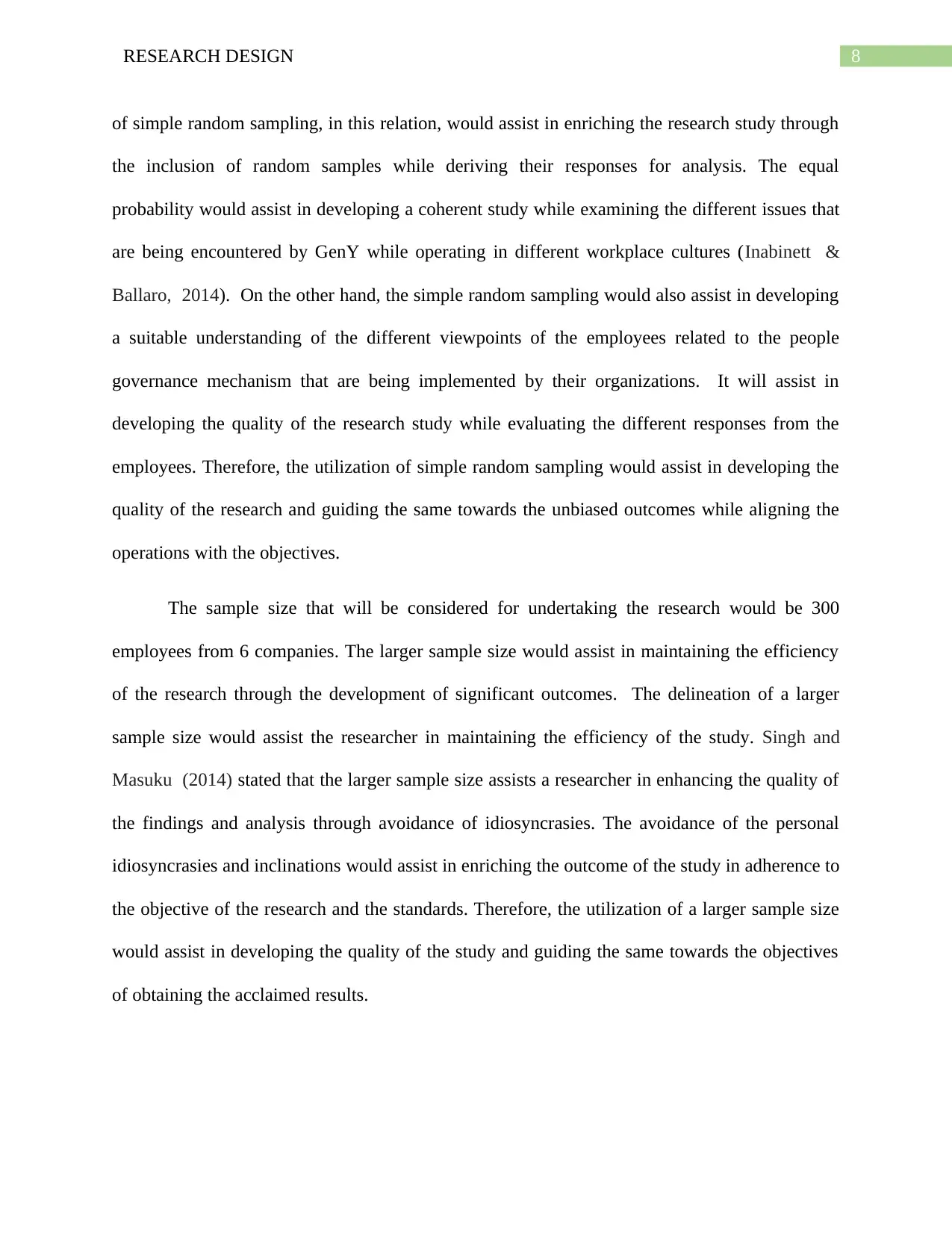
8RESEARCH DESIGN
of simple random sampling, in this relation, would assist in enriching the research study through
the inclusion of random samples while deriving their responses for analysis. The equal
probability would assist in developing a coherent study while examining the different issues that
are being encountered by GenY while operating in different workplace cultures (Inabinett &
Ballaro, 2014). On the other hand, the simple random sampling would also assist in developing
a suitable understanding of the different viewpoints of the employees related to the people
governance mechanism that are being implemented by their organizations. It will assist in
developing the quality of the research study while evaluating the different responses from the
employees. Therefore, the utilization of simple random sampling would assist in developing the
quality of the research and guiding the same towards the unbiased outcomes while aligning the
operations with the objectives.
The sample size that will be considered for undertaking the research would be 300
employees from 6 companies. The larger sample size would assist in maintaining the efficiency
of the research through the development of significant outcomes. The delineation of a larger
sample size would assist the researcher in maintaining the efficiency of the study. Singh and
Masuku (2014) stated that the larger sample size assists a researcher in enhancing the quality of
the findings and analysis through avoidance of idiosyncrasies. The avoidance of the personal
idiosyncrasies and inclinations would assist in enriching the outcome of the study in adherence to
the objective of the research and the standards. Therefore, the utilization of a larger sample size
would assist in developing the quality of the study and guiding the same towards the objectives
of obtaining the acclaimed results.
of simple random sampling, in this relation, would assist in enriching the research study through
the inclusion of random samples while deriving their responses for analysis. The equal
probability would assist in developing a coherent study while examining the different issues that
are being encountered by GenY while operating in different workplace cultures (Inabinett &
Ballaro, 2014). On the other hand, the simple random sampling would also assist in developing
a suitable understanding of the different viewpoints of the employees related to the people
governance mechanism that are being implemented by their organizations. It will assist in
developing the quality of the research study while evaluating the different responses from the
employees. Therefore, the utilization of simple random sampling would assist in developing the
quality of the research and guiding the same towards the unbiased outcomes while aligning the
operations with the objectives.
The sample size that will be considered for undertaking the research would be 300
employees from 6 companies. The larger sample size would assist in maintaining the efficiency
of the research through the development of significant outcomes. The delineation of a larger
sample size would assist the researcher in maintaining the efficiency of the study. Singh and
Masuku (2014) stated that the larger sample size assists a researcher in enhancing the quality of
the findings and analysis through avoidance of idiosyncrasies. The avoidance of the personal
idiosyncrasies and inclinations would assist in enriching the outcome of the study in adherence to
the objective of the research and the standards. Therefore, the utilization of a larger sample size
would assist in developing the quality of the study and guiding the same towards the objectives
of obtaining the acclaimed results.
⊘ This is a preview!⊘
Do you want full access?
Subscribe today to unlock all pages.

Trusted by 1+ million students worldwide
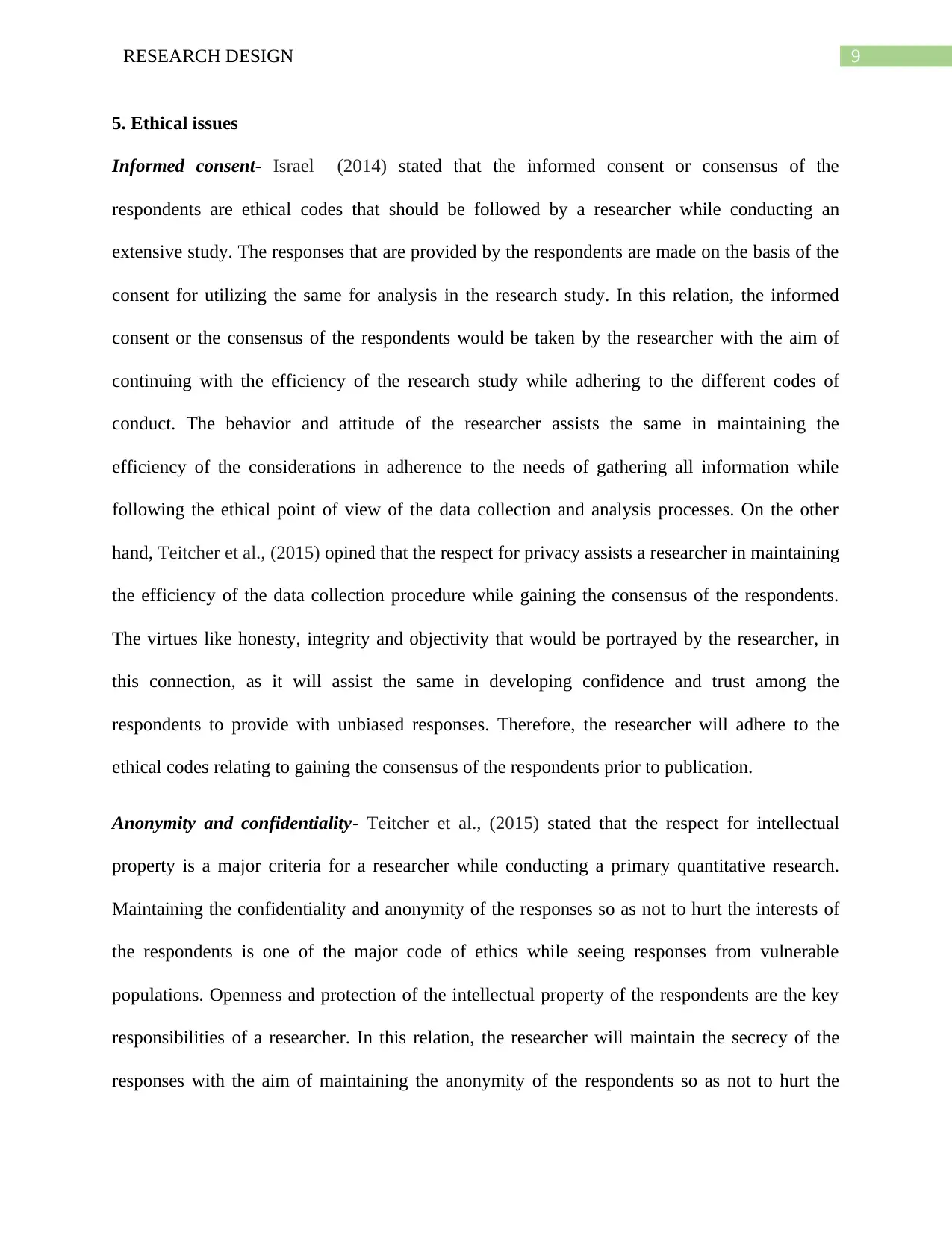
9RESEARCH DESIGN
5. Ethical issues
Informed consent- Israel (2014) stated that the informed consent or consensus of the
respondents are ethical codes that should be followed by a researcher while conducting an
extensive study. The responses that are provided by the respondents are made on the basis of the
consent for utilizing the same for analysis in the research study. In this relation, the informed
consent or the consensus of the respondents would be taken by the researcher with the aim of
continuing with the efficiency of the research study while adhering to the different codes of
conduct. The behavior and attitude of the researcher assists the same in maintaining the
efficiency of the considerations in adherence to the needs of gathering all information while
following the ethical point of view of the data collection and analysis processes. On the other
hand, Teitcher et al., (2015) opined that the respect for privacy assists a researcher in maintaining
the efficiency of the data collection procedure while gaining the consensus of the respondents.
The virtues like honesty, integrity and objectivity that would be portrayed by the researcher, in
this connection, as it will assist the same in developing confidence and trust among the
respondents to provide with unbiased responses. Therefore, the researcher will adhere to the
ethical codes relating to gaining the consensus of the respondents prior to publication.
Anonymity and confidentiality- Teitcher et al., (2015) stated that the respect for intellectual
property is a major criteria for a researcher while conducting a primary quantitative research.
Maintaining the confidentiality and anonymity of the responses so as not to hurt the interests of
the respondents is one of the major code of ethics while seeing responses from vulnerable
populations. Openness and protection of the intellectual property of the respondents are the key
responsibilities of a researcher. In this relation, the researcher will maintain the secrecy of the
responses with the aim of maintaining the anonymity of the respondents so as not to hurt the
5. Ethical issues
Informed consent- Israel (2014) stated that the informed consent or consensus of the
respondents are ethical codes that should be followed by a researcher while conducting an
extensive study. The responses that are provided by the respondents are made on the basis of the
consent for utilizing the same for analysis in the research study. In this relation, the informed
consent or the consensus of the respondents would be taken by the researcher with the aim of
continuing with the efficiency of the research study while adhering to the different codes of
conduct. The behavior and attitude of the researcher assists the same in maintaining the
efficiency of the considerations in adherence to the needs of gathering all information while
following the ethical point of view of the data collection and analysis processes. On the other
hand, Teitcher et al., (2015) opined that the respect for privacy assists a researcher in maintaining
the efficiency of the data collection procedure while gaining the consensus of the respondents.
The virtues like honesty, integrity and objectivity that would be portrayed by the researcher, in
this connection, as it will assist the same in developing confidence and trust among the
respondents to provide with unbiased responses. Therefore, the researcher will adhere to the
ethical codes relating to gaining the consensus of the respondents prior to publication.
Anonymity and confidentiality- Teitcher et al., (2015) stated that the respect for intellectual
property is a major criteria for a researcher while conducting a primary quantitative research.
Maintaining the confidentiality and anonymity of the responses so as not to hurt the interests of
the respondents is one of the major code of ethics while seeing responses from vulnerable
populations. Openness and protection of the intellectual property of the respondents are the key
responsibilities of a researcher. In this relation, the researcher will maintain the secrecy of the
responses with the aim of maintaining the anonymity of the respondents so as not to hurt the
Paraphrase This Document
Need a fresh take? Get an instant paraphrase of this document with our AI Paraphraser
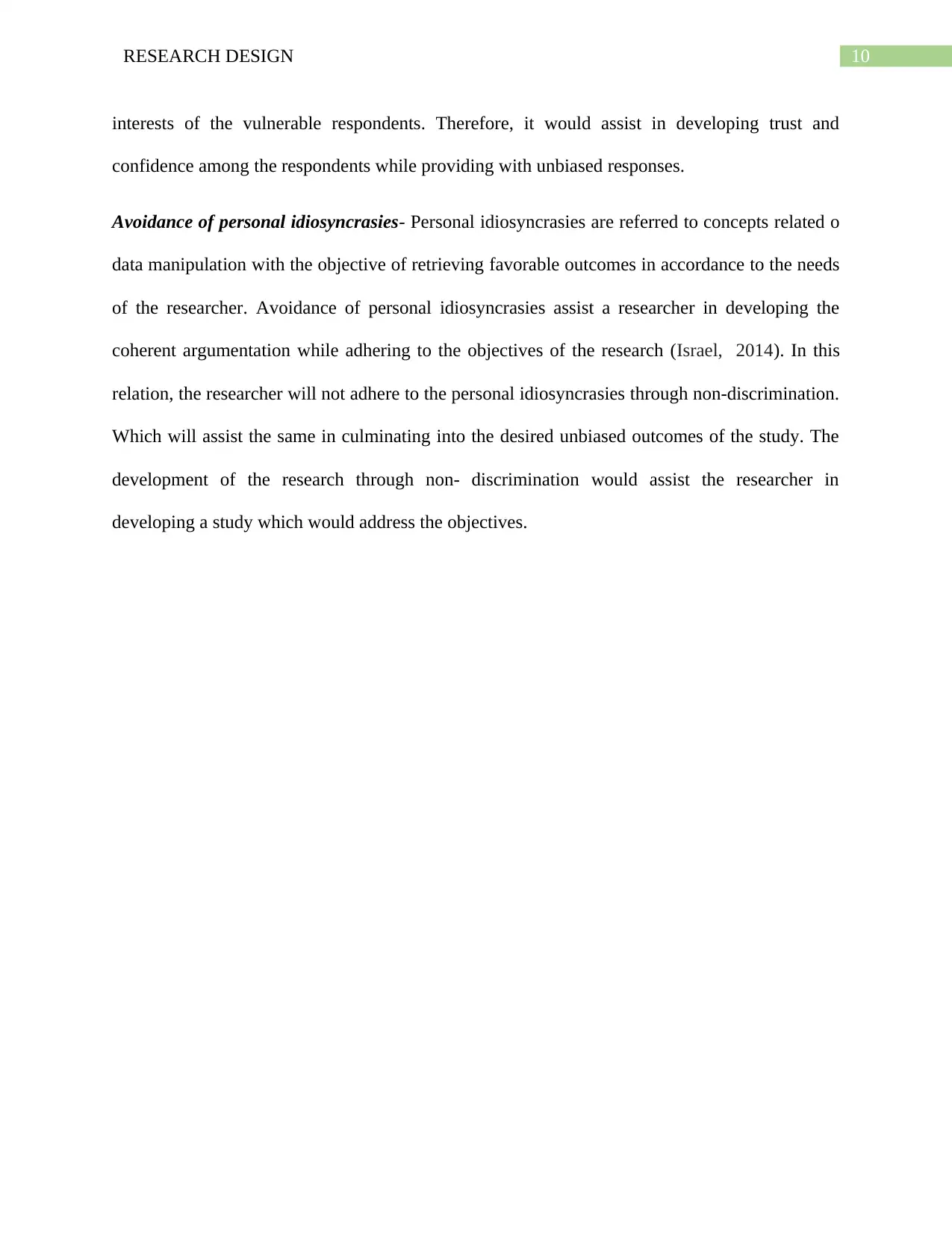
10RESEARCH DESIGN
interests of the vulnerable respondents. Therefore, it would assist in developing trust and
confidence among the respondents while providing with unbiased responses.
Avoidance of personal idiosyncrasies- Personal idiosyncrasies are referred to concepts related o
data manipulation with the objective of retrieving favorable outcomes in accordance to the needs
of the researcher. Avoidance of personal idiosyncrasies assist a researcher in developing the
coherent argumentation while adhering to the objectives of the research (Israel, 2014). In this
relation, the researcher will not adhere to the personal idiosyncrasies through non-discrimination.
Which will assist the same in culminating into the desired unbiased outcomes of the study. The
development of the research through non- discrimination would assist the researcher in
developing a study which would address the objectives.
interests of the vulnerable respondents. Therefore, it would assist in developing trust and
confidence among the respondents while providing with unbiased responses.
Avoidance of personal idiosyncrasies- Personal idiosyncrasies are referred to concepts related o
data manipulation with the objective of retrieving favorable outcomes in accordance to the needs
of the researcher. Avoidance of personal idiosyncrasies assist a researcher in developing the
coherent argumentation while adhering to the objectives of the research (Israel, 2014). In this
relation, the researcher will not adhere to the personal idiosyncrasies through non-discrimination.
Which will assist the same in culminating into the desired unbiased outcomes of the study. The
development of the research through non- discrimination would assist the researcher in
developing a study which would address the objectives.
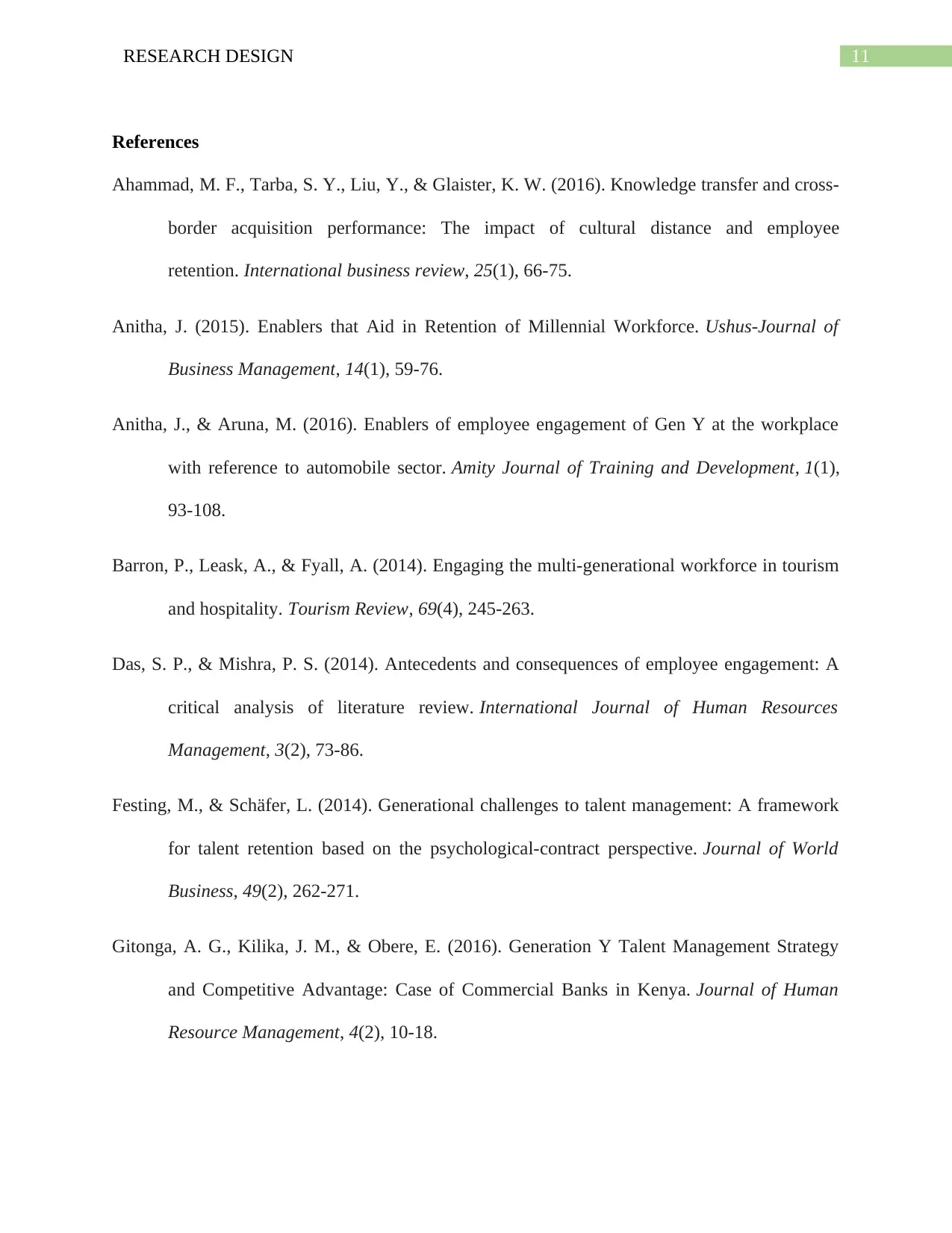
11RESEARCH DESIGN
References
Ahammad, M. F., Tarba, S. Y., Liu, Y., & Glaister, K. W. (2016). Knowledge transfer and cross-
border acquisition performance: The impact of cultural distance and employee
retention. International business review, 25(1), 66-75.
Anitha, J. (2015). Enablers that Aid in Retention of Millennial Workforce. Ushus-Journal of
Business Management, 14(1), 59-76.
Anitha, J., & Aruna, M. (2016). Enablers of employee engagement of Gen Y at the workplace
with reference to automobile sector. Amity Journal of Training and Development, 1(1),
93-108.
Barron, P., Leask, A., & Fyall, A. (2014). Engaging the multi-generational workforce in tourism
and hospitality. Tourism Review, 69(4), 245-263.
Das, S. P., & Mishra, P. S. (2014). Antecedents and consequences of employee engagement: A
critical analysis of literature review. International Journal of Human Resources
Management, 3(2), 73-86.
Festing, M., & Schäfer, L. (2014). Generational challenges to talent management: A framework
for talent retention based on the psychological-contract perspective. Journal of World
Business, 49(2), 262-271.
Gitonga, A. G., Kilika, J. M., & Obere, E. (2016). Generation Y Talent Management Strategy
and Competitive Advantage: Case of Commercial Banks in Kenya. Journal of Human
Resource Management, 4(2), 10-18.
References
Ahammad, M. F., Tarba, S. Y., Liu, Y., & Glaister, K. W. (2016). Knowledge transfer and cross-
border acquisition performance: The impact of cultural distance and employee
retention. International business review, 25(1), 66-75.
Anitha, J. (2015). Enablers that Aid in Retention of Millennial Workforce. Ushus-Journal of
Business Management, 14(1), 59-76.
Anitha, J., & Aruna, M. (2016). Enablers of employee engagement of Gen Y at the workplace
with reference to automobile sector. Amity Journal of Training and Development, 1(1),
93-108.
Barron, P., Leask, A., & Fyall, A. (2014). Engaging the multi-generational workforce in tourism
and hospitality. Tourism Review, 69(4), 245-263.
Das, S. P., & Mishra, P. S. (2014). Antecedents and consequences of employee engagement: A
critical analysis of literature review. International Journal of Human Resources
Management, 3(2), 73-86.
Festing, M., & Schäfer, L. (2014). Generational challenges to talent management: A framework
for talent retention based on the psychological-contract perspective. Journal of World
Business, 49(2), 262-271.
Gitonga, A. G., Kilika, J. M., & Obere, E. (2016). Generation Y Talent Management Strategy
and Competitive Advantage: Case of Commercial Banks in Kenya. Journal of Human
Resource Management, 4(2), 10-18.
⊘ This is a preview!⊘
Do you want full access?
Subscribe today to unlock all pages.

Trusted by 1+ million students worldwide
1 out of 14
Related Documents
Your All-in-One AI-Powered Toolkit for Academic Success.
+13062052269
info@desklib.com
Available 24*7 on WhatsApp / Email
![[object Object]](/_next/static/media/star-bottom.7253800d.svg)
Unlock your academic potential
Copyright © 2020–2025 A2Z Services. All Rights Reserved. Developed and managed by ZUCOL.





